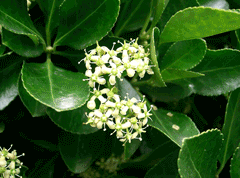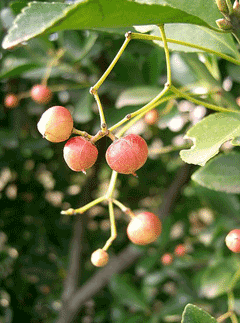 |
|
http://commons.wikimedia.org/wiki/User:KENPEI |
 |
| http://commons.wikimedia.org/wiki/User:KENPEI |
Translate this page:
Summary
Bloom Color: Green, White.
Main Bloom Time: Early summer, Late spring. Form: Oval, Upright or erect, Vase.
Physical Characteristics

 Euonymus japonicus is an evergreen Shrub growing to 4.5 m (14ft) by 2 m (6ft) at a medium rate.
Euonymus japonicus is an evergreen Shrub growing to 4.5 m (14ft) by 2 m (6ft) at a medium rate.
See above for USDA hardiness. It is hardy to UK zone 7. It is in leaf all year, in flower from May to June. The species is hermaphrodite (has both male and female organs) and is pollinated by Insects.
Suitable for: light (sandy), medium (loamy) and heavy (clay) soils, prefers well-drained soil and can grow in heavy clay soil. Suitable pH: mildly acid, neutral and basic (mildly alkaline) soils. It can grow in semi-shade (light woodland) or no shade. It prefers dry or moist soil. The plant can tolerate maritime exposure.
UK Hardiness Map
US Hardiness Map
Synonyms
Plant Habitats
Woodland Garden Sunny Edge; Dappled Shade; Shady Edge; Hedge;
Edible Uses
Edible Parts: Leaves
Edible Uses: Colouring
Young leaves - boiled[2, 177, 183]. The old leaves are powdered and used to colour food[105, 177, 183]. These reports should be treated with some caution due to the report of toxicity - see above.
References More on Edible Uses
Medicinal Uses
Plants For A Future can not take any responsibility for any adverse effects from the use of plants. Always seek advice from a professional before using a plant medicinally.
Antirheumatic Diuretic Tonic Women's complaints
The stem bark is antirheumatic, diuretic and tonic[218]. The leaf is used in cases of difficult delivery[218].
References More on Medicinal Uses
The Bookshop: Edible Plant Books
Our Latest books on Perennial Plants For Food Forests and Permaculture Gardens in paperback or digital formats.

Edible Tropical Plants
Food Forest Plants for Hotter Conditions: 250+ Plants For Tropical Food Forests & Permaculture Gardens.
More

Edible Temperate Plants
Plants for Your Food Forest: 500 Plants for Temperate Food Forests & Permaculture Gardens.
More

More Books
PFAF have eight books available in paperback and digital formats. Browse the shop for more information.
Shop Now
Other Uses
Hedge Hedge Latex
Roots and stems yield up to 7% gutta-percha, a non elastic rubber used as an electrical insulator and in making plastics etc[61, 74, 103]. Can be grown as a hedge, it is very tolerant of trimming and succeeds in severe maritime exposure[11, 75, 200].
Special Uses
Hedge Hedge
References More on Other Uses
Cultivation details
Landscape Uses:Border, Container, Foundation, Hedge, Massing, Screen, Specimen, Woodland garden. Thriving in almost any soil, including chalk and sandy soils, it is particularly suited to dry shaded areas[200]. Grows well in heavy clay soils. Shade tolerant but does not fruit well in such a position[11]. Prefers a well-drained loamy soil[11]. Plants are very tolerant of maritime exposure, succeeding even when grown on the sea shore[166], but they can be killed by cold drying winds[75, 184]. A very ornamental plant[1], there are a number of named varieties[184]. It is only hardy in S. England[11] tolerating temperatures down to about -10°c[184]. Plants are more likely to succumb to the cold if they are regularly trimmed (this exposes young growth to the cold), this regular trimming also leads to mildew especially when plants are growing in very dry ground[182]. The Japanese spindle tree is cultivated in Russia and Spain for the latex contained in the root. It is best grown in a dry soil and an open position when being grown for its latex[61, 74]. Plants are often slow to get established. Plants can be susceptible to attacks by caterpillars[182] and are often damaged during the flowering season[11]. They are also a host of the sugar beet fly[49]. This species is notably resistant to honey fungus[200]. Special Features:
Not North American native, Naturalizing, Inconspicuous flowers or blooms.
References Carbon Farming Information and Carbon Sequestration Information
Temperature Converter
Type a value in the Celsius field to convert the value to Fahrenheit:
Fahrenheit:
The PFAF Bookshop
Plants For A Future have a number of books available in paperback and digital form. Book titles include Edible Plants, Edible Perennials, Edible Trees,Edible Shrubs, Woodland Gardening, and Temperate Food Forest Plants. Our new book is Food Forest Plants For Hotter Conditions (Tropical and Sub-Tropical).
Shop Now
Plant Propagation
Seed - best sown as soon as it is ripe in a cold frame[121]. Stored seed requires 3 months cold stratification, so should be sown as early in the year as possible in a cold frame[113]. Seed can take 18 months to germinate[74]. When they are large enough to handle, prick the seedlings out into individual pots and grow them on in the greenhouse for at least their first winter. Plant them out into their permanent positions in late spring or early summer, after the last expected frosts. Cuttings of half-ripe wood, 5 - 7cm long taken at a node or with a heel, July/August in a frame. Very easy[200]. Cuttings of mature wood, October in a frame78, 113]. Cuttings will root readily at any time of the year if given bottom heat[1]. Root cuttings in winter.
Other Names
If available other names are mentioned here
Native Range
TEMPERATE ASIA: Korea, Japan (Hokkaidô (south), Honshu, Kyushu, Ryukyu Islands, Shikoku)
Weed Potential
Right plant wrong place. We are currently updating this section.
Please note that a plant may be invasive in one area but may not in your area so it's worth checking.
Conservation Status
IUCN Red List of Threatened Plants Status :

Growth: S = slow M = medium F = fast. Soil: L = light (sandy) M = medium H = heavy (clay). pH: A = acid N = neutral B = basic (alkaline). Shade: F = full shade S = semi-shade N = no shade. Moisture: D = dry M = Moist We = wet Wa = water.
Now available:
Food Forest Plants for Mediterranean Conditions
350+ Perennial Plants For Mediterranean and Drier Food Forests and Permaculture Gardens.
[Paperback and eBook]
This is the third in Plants For A Future's series of plant guides for food forests tailored to
specific climate zones. Following volumes on temperate and tropical ecosystems, this book focuses
on species suited to Mediterranean conditions—regions with hot, dry summers and cool, wet winters,
often facing the added challenge of climate change.
Read More
Expert comment
Author
Thunb.
Botanical References
1158200
Links / References
For a list of references used on this page please go here
Readers comment
© 2010, Plants For A Future. Plants For A Future is a charitable company limited by guarantee, registered in England and Wales. Charity No. 1057719, Company No. 3204567.